2008 GAMES ARCHIVES
12-31-08: Left 4 Dead Review (XBox 360)
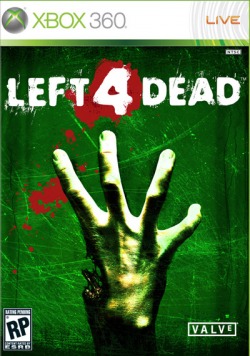
by Brian LeTendre
At first glance, Left 4 Dead may seem like a one-trick pony that isn’t worth the price of a full game. While that may be true of the single player experience, once you play the multiplayer modes you’ll find that it’s worth its weight in zombies ten times over.
Left 4 Dead is a first person shooter that follows 4 regular joes who are trying to survive the zombie apocalypse. There’s Louis, your average 9 to 5’er, Francis the biker dude, Bill the Vietnam vet, and Zoey the college girl. These four have been thrown together and forced to depend on one another as they try to escape various locations teeming with swarms of the undead.
The game is structures into four “movies,” which consist of multiple levels linked by a common theme. The group must battle through different areas, stopping briefly at safe houses, until they find a way to escape. For example, the “No Mercy” movie involves making it across town to the local hospital in order to catch a ride out of town on a chopper. The final battle is a frantic defense of your position as you are waiting to be airlifted out.
In addition to the hordes of zombies that are trying to destroy you, there are also several “boss” characters that can pop up anywhere along the way. These are enhanced creatures, each with a distinct way of attacking and causing problems for players. The “Smoker” uses his ridiculously long tongue to grab you and pull you away from your friends; the “Boomer” throws up on you, which immediately attracts hundreds of zombies to you; the “Hunter” can scale walls and jump long distances, and deals massive damage with attacks, and the “Tank” is a raging hulk that destroys everything in its path. And let’s not forget about the “Witch.” The only thing you need to know about her is that you should stay far away from her…
Weapons in the game range from pistols to assault rifles, and a few in between. You can also pick up Molotov cocktails and pipe bombs, which come in handy when you need to take out large groups at a time—which is pretty much always.
Where Left 4 Dead succeeds the most is in capturing the frantic horror and atmosphere of a great zombie movie. The unique AI director populates the game with zombies and bosses based on many factors, including the skill level of the players and their health status, making each play through a totally different experience. The pacing in the game is fantastic, ramping up at random moments, and each stage culminates in an epic firefight that often results in one or more team members not making it out alive.
Both the single player and multiplayer modes of the game feature the same maps and storylines; however the experiences could not be more different. In single player, you will be accompanied by three AI controlled teammates. The AI is exceptional, and it’s still a great time playing through each level. The game really shines when you get together with friends, though. The screaming, laughing and yelling at each other only contributes to the frantic nature of the game, and each play through provides you with different stories to tell coming away from it. Four maps may not seem like a lot, but the AI ensures that each play through is unique.
As a multiplayer game, Left 4 Dead is an absolute blast and is highly recommended. As an offline game, there’s still a lot to enjoy, but you may want to wait until the price drops before investing. Either way, Valve has created the definitive zombie game, and games like Silent Hill, Dead Rising and the Resident Evil series may need to shake up their formulas to compete in the future.
4.5 out of 5 Don't Startle the Witches
12-20-08: Legendary Review (XBox360)
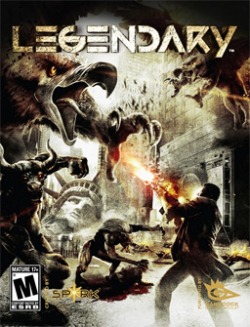
by Brian LeTendre
Legendary is a fast-paced, fun shooter that offers a unique take on the genre, even if it doesn't quite live up to its name.
In the game, players take on the role of Charles Deckard, an art thief who unwittingly opens the mythical “Pandora's Box,” unleashing ancient creatures of lore into the world. He then must team up with a secret military organization and find a way to close the box and keep a madman and his splinter group from gaining control of it and destroying the world.
One of the things I noticed immediately about the game is that the developers (Spark Unlimited) had a truly ambitious vision for the game. From the set pieces of New York and London, to the scale of the gigantic Golems and Krakens, there are times where Legendary looks like a bigger game than it is, which is a window into what the developers might have done with more resources. As it is, Deckard is often operating on a smaller scale, with larger events going on around him. That's not necessarily a bad thing, as there's plenty to keep him occupied, namely werewolves, fire drakes, griffons and minotaurs. Oh, and let's not forget about the paramilitary soldiers from “The Black Order,” who are trying to kill Deckard and wield the power of Pandora's Box.
The gameplay combines traditional first-person shooting and a Bioshock-esque power system, where Deckard can absorb energy from fallen enemies and channel it into blasts that can stun or even decapitate foes. Using these two elements effectively becomes more and more important as the game goes on. For example, Minotaurs can sustain a ton of damage, but are more vulnerable from behind. Stunning them to get behind them is the easiest way to take them down. There's a good variety of weapons in the game, ranging from pistols to flamethrowers and everything in between. The controls can feel a little floaty at first, but once you settle in, you'll be pulling off headshots like a pro.
Deckard has a PDA through which he intercepts messages and picks up information, and this becomes the primary way of getting story updates in the game. It works fine, however the game pauses and takes you into a sub menu whenever you use it, which can interrupt the action at times. The rest of the story is conveyed through cut scenes and storyboards, which oddly was the only place in the game I experienced any frame rate issues, as the transition from cut scene to storyboard sometimes caused the game to slow down or even skip a second or two. Luckily, I did not have any of the same issues during gameplay.
Graphically the game is a mixed bag. Some of the larger set pieces and monsters look great, while the supporting cast members could have used some additional polish. The in-game animations looked good, and there is even a nod to old school light gun games, as claw marks will appear on screen when Deckard takes damage from werewolves or other clawed creatures.
The game ends with a bit of a twist, and leaves the door open for a possible sequel. I for one would like to see that happen, hopefully with a bigger budget. I'd love to see what the developers could do with Call of Duty or Gears of War type money. Even without all the bells and whistles, Legendary provides a nice departure from many other shooters, and its ambition deserves to be recognized.
3.5 out of 5 Minotaurs
12-1-08: Ninjatown Review (DS)
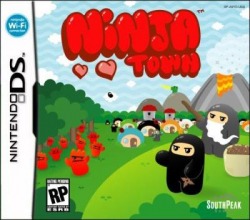
by Brian LeTendre
Based on Shawn Smith’s line of Shawnimals plush toys, Ninjatown is a very challenging strategy game hiding behind a cute and cuddly aesthetic.
Ninjatown is a small peaceful village in the Shawnimals world that is populated by, you guessed it, ninjas. The ninjas spend their days practicing their skills and making cookies. On either side of Ninjatown are potential dangers that could threaten their way of life. Mt.Feroshi is a giant volcano that the ninjas believe is ruled by Mr. Feroshi, the giant dino slug. They pay tribute to him in order to keep the volcano from erupting. On the other side of town is the DarkForest, which is ruled over by Mr. Demon. Mr. Demon has an army of Wee Devils and his goal is to invade Ninjatown and get the recipe for the ninja cookies. It’s Mr. Demon’s nefarious plot that forms the narrative of the Ninjatown game.
The gameplay is very simple at its core. There are several different types of ninja in Ninjatown, and each type of ninja has a different set of skills. Each type of ninja is a distinct color, making it easy to associate them with their skill set. For example, the Wee Ninja are dressed in black, and are the standard units in the game, as their skills are balanced between speed and strength. Anti-Ninjas are orange, as they have forsaken speed and stealth in the name of strength and more powerful attacks. White Ninjas have ranged attacks, as they throw snowballs that slow down enemies. There are several more types of ninja, and you unlock them as the game progresses. You also unlock special attacks, which come either in the form of tokens that can be used one at a time, or special “’Ol Master Ninja” attacks that require you to do things like blow or speak into the microphone.
In each level of play, Mr. Demon is sending his Wee Devils (of which there are also many types) into Ninjatown. Your job is build different types of Ninja Huts in strategic places in order to defeat the Wee Devils before they can reach their goal on any given level. You buy huts with Ninja Cookies, which are the game equivalent of money. Each hut contains two ninjas, and you can level up each hut several times, improving the attacks and defenses of each group of ninjas. As you defeat enemies, you’ll earn more cookies, which can be used to build more Ninja Huts, or upgrade existing ones. Certain ninjas will fair better against certain enemies, so it’s imperative that you choose wisely when setting up your Ninja Huts.
Each level takes about 10-15 minutes to play, which makes it a great DS game that you can play chunks of whenever you have a small amount of time. When you complete each level, you will be graded on your performance, on a scale of “A” through “D” based on how many enemies made it through your defenses. If you let too many through, you will have to start the level over. If that happens a few times in a row, the game will ask you if you want to try the level in Easy mode. This is a nice feature which should save you from getting too frustrated with any one level. If you complete the level on Easy mode, you will receive a grade of “E,” but will still be able to move on to the next level.
The game does a great job of introducing you to the basics, and then slowly ramping up the level of difficulty. If you’re not careful, the game will actually sneak up on you, as you can be lulled into a false sense of security after a few easy levels. This happened to me on a level where there were multiple points of entry for the Wee Devils. I did a nice job of protecting one point of entry, but neglected the other until it was too late. I had to try the level over a few times before completing it, as the wrong combination of ninja types will result in your defenses being overrun pretty quickly. When you do complete a level though, it’s very satisfying and you feel like you’ve earned it.
The game features a multiplayer mode that allows two players to compete for scores on the same map. Two players can access a few of the maps off of one cartridge, but there are several more maps in multiplayer if each person has a copy of the game.
My one concern with the game is that it is really difficult to rally if you make a mistake. You can sell off Ninja Huts in order to build other elsewhere, but once the pace of the game picks up, it’s very difficult to switch tactics. The decisions you make at the start of the level go a long way toward determining victory or defeat, and since you don’t really know the different types of enemies you’ll be facing, it’s fairly easy to make the wrong choice early. However, the positive side of this is that you learn very early not to waste any time or actions in the crucial early moments of a level.
All in all, Ninjatown is a great game, and one of the best I’ve played on the DS. While it’s easy to pick up and play, the game has a lot of variety and becomes extremely challenging as it progresses. Hardcore gamers will be impressed with the level of strategy involved, while the ability to fall back on Easy mode makes the game more accessible to kids or casual gamers. Here’s hoping we’ll see more entries in the series, perhaps featuring some of the other inhabitants of Shawnimal Land.
5 out of 5 Ninja Cookies
11-27-08: Resistance 2 Review (PS3)
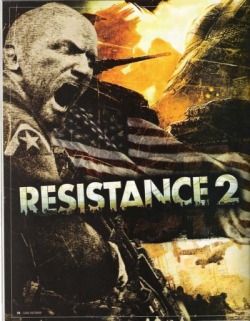
by Brian LeTendre
Resistance 2 is a bigger, better version of the original, but it fails to deliver as one of the more anticipated shooters of the year.
For those unfamiliar with the franchise, Resistance takes place in an alternate history where the world is invaded by the Chimera, an extraterrestrial species that is systematically taking over the world and turning humans into modified versions of themselves. The main hero of the Resistance games is Nathan Hale, a US Army Ranger who has been infected with the Chimeran virus, but has not completely transformed, leaving him with enhanced abilities. The storyline in Resistance 2 sees the Chimera launching a full scale invasion of the United States.
While the story of Resistance is on par with similar games like Halo and Gears of War, it’s nothing to write home about. You play as Hale and try to stave off an invasion of the country, while also trying to solve the mystery of the Chimera and save yourself from transforming into a full-blown Chimera yourself.
Developer Insomniac definitely had a bigger budget to work with this time around, and for the most part, it shows. Sets pieces are much larger in scale, and some of the bosses in the game are absolutely huge. You get a good sense of the fact that man is really outmatched and the odds are with the Chimera when you see the scale of the invasion. On many levels, large battles are taking place in the background while you are sneaking through buildings and streets. The game does a nice job of conveying the sense that things are happening all over the place, not just with Nathan Hale.
Graphically however, the game is a mixed bag. Character models are ok, but are certainly not on par with call of Duty 4 or Gears of War 2. Backgrounds and sets are impressive though, and the aforementioned background skirmishes look great, when you have time to stop and appreciate them. Controls are tight, but are poorly designed. The melee button is originally mapped to the right analog stick, which is very sensitive in the PS3 controller. This leads to a lot of unintentional melee attacks when you are trying to aim or look around, which is very frustrating, especially in multiplayer. You can customize the controls, so at the end of the day it’s not a huge deal.
The biggest disappointment in playing through the single player campaign is the archaic level design. You essentially travel from kill room to kill room in a very predictable way. Rooms feature a point of no return, such as a broken staircase that you can’t go back up, or a door that closes and locks behind you. You are also forced to learn by dying, as there are many “monster closet” moments that you won’t figure out until you’re already dead. The paths through each level are extremely linear, leaving little room for strategy. Invisible walls round out the list of shooter clichés that a title of this magnitude should not suffer from.
As frustrating as the single player experience can be, the multiplayer pretty much makes up for it. With up to 60 player matches at a time, the multiplayer offers a great variety of modes, maps, weapons and customization. There is also a co-op mode where you can assume classes and play through squad based missions with your friends. Almost every aspect of multiplayer works well and is polished, leading me to wonder if most of the resources went into that aspect of the game, as opposed to the single player campaign. In any case, good multiplayer is what gives a game legs, and Resistance 2’s multiplayer is arguably the best on the PS3. That fact alone makes it a must buy for PS3 owners.
As a total package, Resistance 2 is a very good game, and one that should be in every PS3 owner’s library. It’s just not on par with other AAA shooters in terms of design and polish, and the single player experience fails to live up to the hype.
4 out of 5 Invasion USA’s
11-25-08: Call of Duty: World at War Review (XBox 360)
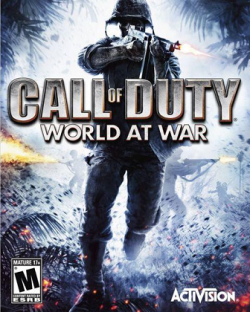
by Brian LeTendre
Call of Duty: World at War is the latest game in the franchise, and features a return to World War II after last year’s modern warfare offering. A lot of fans were hesitant about this game, both because of the return to an earlier era and because it was being developed by Treyarch (as opposed to CoD4’ Infinity Ward). After playing it however, I can safely say that fans have nothing to worry about. World at war is a great game, and in some ways surpasses its predecessor.
The single player campaign follows two main storylines that cover the final battles of World War II. In one storyline you are Private Miller of the USMC, battling the Japanese in the PacificIslands. The other storyline has you taking on the role of Private Pitrenko in the Soviet Red Army, which is marching toward Berlin and taking revenge on the Germans for what happened in Stalingrad. Both storylines are well paced, building up to two of the major battles at the end of the war. Treyarch does a great job of keeping you immersed in the action, and in each story you are accompanied by a superior officer. On the American side, Keifer Sutherland provides the voice of Sgt. Roebuck, while Gary Oldman plays the role of Soviet Sgt. Reznov. Whether they are barking orders at you or giving inspirational speeches, it serves to keep you grounded in the moment and gives an emotional weight to what is going on around you. In between levels of the game are some great cut scenes and statistics about the War, which further lends a level of realism that Call of Duty 4 was not able to achieve.
The co-op multiplayer portion of the game is something that CoD4 did not have, and it’s really fun. Playing through levels of the campaign with a few of your buddies is a great time, and the competitive scoring keeps it fresh each time through. The remainder of the multiplayer modes will feel familiar to players of CoD4. You earn experience points and level up, which unlocks weapons, perks and customization options. The level cap is 65, at which point you can start all over again and reset all of the unlockables. There are a variety of maps and modes, and the addition of vehicles to the mix adds enough to make the multiplayer not feel like just a re-skinning of last year’s game. There is also a special “Nazi Zombie” mode that you unlock once you finish the single player campaign. You and your friends are holed up in an abandoned building while wave after wave of undead continually assault you from all directions. The speed and number of the zombies ramps up with each round, and you earn points that are used to buy bigger and better weapons to battle the undead with.
Overall, Call of Duty: World at War is a more than worthy successor to CoD4, and the engaging campaign may even be better. Multiplayer is still great, and the tweaks that Treyarch has made to this year’s game will be more than enough to keep players busy until Infinity Ward’s next entry into the series.
4.5 out of 5 Victories
11-17-08: Dead Space Review (PS3)
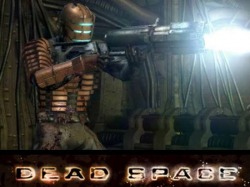
by Brian LeTendre
Horror is a tough genre to pull off in a video game. Horror depends on tension and atmosphere, both of which are hard to keep up over a long period of time. Most horror movies are under two hours, and many of them can't keep the viewer on the edge of their seat. So it's all the more impressive that Dead Space managed to keep me on the edge of mine for thirteen hours.
Dead Space is a brilliant game that combines elements of Event Horizon, Aliens and Night of the Living Dead with great controls, an intriguing story and incredible visuals. The story follows Isaac Clarke, an engineer sent to repair the communications array on the interstellar mining ship, the USG Ishimura. The Ishimura mysteriously lost contact after completing a mining mission in the fear reaches of space. When Isaac arrives with a small crew to find out what happened, he discovers that the ship has been overrun by Necromorphs, alien parasites that infect and reanimate dead tissue. As he fights to survive, he begins to uncover the origin of the Necromorphs, and also learns what it's going to take to stop them once and for all.
Graphically, Dead Space is gorgeous. While most of the action takes place within the giant mining ship, EA does a great job of offering varied locations and set pieces. There are times where you'll find yourself staring through a window out at an asteroid field, or stopping to check out the posters and advertisements on the walls, which are usually followed by some horrific monster driving a claw through your shoulder, as they're not ones for sightseeing. The creature designs are sufficiently disgusting, and the combat is very visceral. In terms of gore, this may be the bloodiest game I’ve ever played. The main way of defeating enemies is to dismember them, so you can imagine how the body parts pile up when you’re faced with a swarm of enemies.
Gameplay is great. The controls are tight, and the camera was never an issue. There are times where monsters jump out at you, but it’s not quite the “monster closet” mechanic that Doom was famous for. Most of the time you can see the enemies coming, and you have a chance to react. It’s when you don’t react well that things can spiral out of control quickly, which totally ramps up the tension. My only real complaint is that the game does not pause when you go into the inventory, however weapons and health packs are hot keyed, so it wasn’t that big of a deal.
Overall, Dead Space does a fantastic job of creating a good horror story and keeping you immersed in it for the entire game. It’s easily the best horror game I’ve ever played, and I think it surpasses the current king of the hill, Resident Evil 4. EA has also done a great job of supporting the IP, with a comic (written by Antony Johnston) and an animated movie (written by Justin Gray and Jimmy Palmiotti). It’s likely that this is the start of a franchise, and they’re off to a great start.
5 out of 5 Severed Limbs
11-6-08: Fable 2 Review (XBox 360)
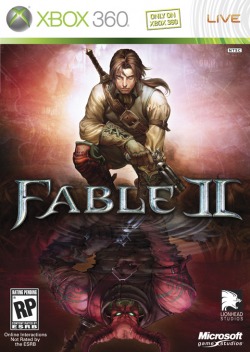
by Brian LeTendre
I can say without reservation that Fable 2 is the best RPG that I've ever played. Ever. Peter Molyneux and Lionhead Studios have delivered a game that tells a great story and is an absolute joy to play, so much so that I was actually sad when I finished it.
The story of Fable 2 begins during the childhood of the main character. You can choose to be either a girl or a boy, and you'll spend some time adventuring as a child before the first major event of the game takes place. When it does, you lose someone close to you, which sets the table for the rest of the game's narrative. The story then becomes one of revenge, and the choice is yours in terms of how far you'll go to get it.
The story makes up the backbone of the game, however it's the gameplay and the way that the world unfolds before you that makes Fable 2 great. You can choose to be good or evil, corrupt or pure, or somewhere in between. Every deed, interaction and action will affect how those around you precieve and react to you. Treat people poorly, and you become an outcast. Shop owners charge you more, people will avoid you, and your appearance will start to change. Become corrupt, you start to grow horns. Become evil, you turn a pale, vampirish color. Be the pure hero, and you might even earn a halo by the end of the game.
The controls are very simple, with each type of attack being assigned to a button. For stronger attacks, you hold a button down longer, or push a certain direction at just the right time. The experience you earn through encounters is used as currency, to buy better abilities, allowing you to customize your character to fit your style of play. I prefer melee combat, so I used weapons and spells that would compliment my sword skills. The social interaction system is reminiscent of the Sims, as you have the abiltiy to choose different actions or expressions when interacting with people. You can get married, have sex, have kids and even get divorced (not necessarily in that order).
You can power through he main storyline, or busy yourself with endless side quests. You can even get a job, working as a blacksmith, bartender or woodcutter. Money you make can be invested into local shops and houses, enabling you to generate income. A very cool feature of the game is that money continues to generate from your investments when you aren't playing. It's great to jump into the game after a few days off and find you've made several thousand gold.
Accompanying you along the way is your faithful dog, which just might qualify as the coolest NPC ever. You can teach your dog tricks, fighting techniques, and treasure hunting skills. No matter where you go, the dog follows, and you'll quickly become very attached to it.
The game features Xbox Live co-op, through which a friend can join you in your game as a henchman. While it's unfortunate that they won't be able to use their own character, the co-op still proves to be fun, especially when you combine skills in combat. My only minor quibble was that the camera is fixed, meaning both players will have to make a conscious effort to stay near one another. To be honest though, you won't be playing this game for the co-op, as it's all about the single player experience.
Once you've completed the main storyline, you can continue to adventure in the game world, and there are some quests that won't even be available to you until you finish the story. I was happy to stay and play in the world after finishing, and I expect it will be a while before I tire of adventuring in Fable 2.
Overall, Fable 2 is a wonderful game, and should earn a place on the list of all-time great RPGs. I highly recommend it to everyone.
5 out of 5 Faithful Companions
10-5-08: Star Wars: The Force Unleashed Review (XBox 360)
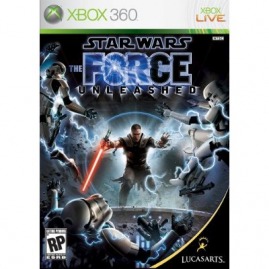
by Armand Nadeau
The Force Unleashed had been on my gaming radar for the better part of two years, and after experiencing shipping delays earlier this year and reading about the pending layoffs at LucasArts, I began to grow concerned as to how the final product would turn out. After having TFU since launch and logging in quite a bit of game time, I think it’s fair to say that I am reasonably satisfied.
The story of TFU takes place between Episodes III and IV where we find that Darth Vader is on a mission to hunt down and destroy any remaining Jedi in the galaxy. Reports from Imperial spies have led Vader to the planet Kashyyyk, a world that played a pivotal role in the Clone Wars, and also home world to the Wookie population. Assuming control of the Sith Lord, we get to experience the raw nature of the Force: splintering trees with Force pushes, Force chokes, levitation, lightsaber combat, etc. It gives a pretty good preview of what to expect from the rest of the game. After completing your primary objective, the story takes a very interesting turn where Vader unexpectedly encounters a small boy who he secretly “adopts” as his apprentice. We then cut to 18 or so years after Episode III where the apprentice is now a young man and begins running Jedi extermination missions for Vader, all in secrecy of course, because the Emperor would not be pleased to learn of this. You may recall that the Sith operate under the “rule of two,” they have a master and an apprentice, and no more. Vader’s actions could easily be interpreted by the Emperor as treachery.
The subsequent missions take place in exotic locations and grow progressively more difficult as you encounter Jedi who have varying degrees of skill with the Force. In addition to facing challenges from those who practice the Light Side, you will also oppose natives of various planets as well as Rebels and Imperials that you must destroy (again, your identity must remain a secret; no witnesses!).
As the story unfolds, the Apprentice eventually learns that Sith cannot be trusted, and he will come to face the difficult decision of which path of the Force to follow: the Light or the Dark. The choice he makes will dictate the ending sequence of the game. One path follows the comic book ending, the other being an alternative.
As far as what I liked about TFU – there is quite a bit. First off, I absolutely loved the CGI intermissions. TFU has a really interesting story that for the most part, I’ve accepted as official Star Wars canon. I enjoyed the cut scenes so much that I often wanted to breeze through the missions quickly so that I could get to the next cinematic segment. I was constantly wondering, “What’s going to happen next??” I think that most Star Wars fans would agree that TFU’s story would have made a very good Episode 3.5.
The new characters are interesting additions to the Star Wars Galaxy and ones that I would like to see appear in additional Expanded Universe material. I also really enjoyed the cameos from Classic Trilogy and Prequel characters that appeared at various points throughout the game. I think their role in TFU added some legitimacy to the overall story.
While I did have some issues with the actual game play, I must admit that it was fun to have the ability to power-up huge Force pushes and send ‘troopers flailing as they hurtle backwards, generate Force Lightning, use my lightsaber as a boomerang, or execute a number of Force-fueled combos to dispatch my opponents. Having these once fabled powers at my disposal and magnified as if the Apprentice was on steroids is a pretty cool experience, despite being a bit far-fetched.
The inclusion of the well-hyped Havok and Euphoria technologies really can’t be enjoyed for what they offer due to the intensity of action throughout the game. There is simply no time to sit back and take it all in. In many instances, you will find yourself facing overwhelming odds, and battling frantically in order to stay alive. Of what I did take notice of, the rag-doll physics are pretty cool.
With regard to actual game play mechanics, I must admit that I was a bit disappointed in some respects. First off, the camera must be controlled manually in order to always have an optimum viewing angle, and at times when on rocky edges or bridges fighting against multiple enemies, it becomes too cumbersome to deal with. If you suffer from “Doom Induced Dizziness” (DID) or vertigo, this game may give you fits as you are required to swing the camera around constantly when fighting enemies who attempt to surround and overwhelm you.
Another issue I have with TFU is the frame rate. During normal gaming sequences, it feels that the game runs under 60fps. When the action heats up with numerous combatants and/or mini-bosses, movement can become a bit choppy. I suppose this is typical for a LucasArts or Star Wars branded game, but in today’s gaming environment, this remains entirely unacceptable. 60fps has become the standard for a high quality console game, and for as long as TFU has been in development, it should be of very high quality – especially considering the resources LucasArts had at their disposal (i.e. Industrial Light and Magic).
Another issue I have with TFU is the fact that as your powers grow stronger, you encounter more enemies who seem to always have some sort of ability or technology to nullify your newly developed skills – whether it is an energy shield or some sort of armor impervious to specific Force powers, as you grow stronger, they do too. There are considerable inconsistencies with this. For example, you can literally Force grab a TIE Fighter out of flight, but yet you can’t levitate a Dark Trooper. To me, this didn’t make any sense whatsoever. Granted, the game would be too easy if you could just crush everyone and every thing in your path, but some of the challenges you face as the game progresses don’t necessarily contribute to the overall flow of the game’s action sequences. As you grow stronger, your opponents should seem weaker. The only fodder for the Apprentice’s unleashed powers is your basic stormtroopers, rebel soldiers, and some planetary natives.
My final gripe is with the Achievement System. I really have a problem when developers aren’t creative when it comes to Achievement Points, and resort to offering rewards when playing through a game at each of the available difficulty settings. I’ll play TFU twice through so that I can see both endings, but I won’t be playing it any more than that simply to get the “Sith Apprentice” easy difficulty award, nor will I attempt it on the most challenging skill level.
All in all, TFU is a nice looking game despite the aforementioned issues, and Star Wars fans will likely enjoy the engaging story which includes quite a few familiar faces. The 3rd –person action is average to slightly above average at best, but as a whole, the game earns a recommendation from me. This is one of those games that is worthy of more than rental status, but probably just at or slightly below a buy for most people. For a Star Wars fan, this game is definitely a must-have. Time to completion on the default difficulty is approximately 12-15 hours depending on how obsessed you are with finding all of the holocrons.
LucasArts has announced that two DLC packs will be made available for The Force Unleashed, one of which will hit the Xbox Live Marketplace before the end of the year.
Please note that my review is based on the Xbox 360 version. After speaking with a friend who has The Force Unleashed on the Wii, there are significant differences in both play mechanics and specific events that take place within the game.
3.5 out of 5 Braided Wookie Scalps
Highs: Very cool story, interesting new characters, familiar faces from the Prequels and Classic Trilogy, and the fun factor associated with having super-embellished Force powers at your disposal.
Lows: Poor camera requires constant manual control for optimum viewing during combat sequences, frame rate is noticeably clunky at times of intense action, poor A.I. in most enemies (and potential allies).
Bottom Line: One of the better Star Wars games produced and likely to be well received by fans of the movies as well as fans of 3rd person action games.
Easter Eggs and Other Notables: Jimmy Smits does the voice of Bail Organa. Tom Kane (voice of the animated Yoda) also lends his talents to voice-work. If you look carefully, Jar-Jar Binks can be found encased in Carbonite and Salacious Crumb’s head can be seen mounted on a wall. The Wilhelm scream appears in TFU. A fan favorite bad guy makes a brief appearance on the Xbox 360 version, but from I’ve been told, not on the Wii during the story mode. Aside from a deleted scene from Episode III, TFU offers an alternative look as to how the Rebel Alliance was formed.
